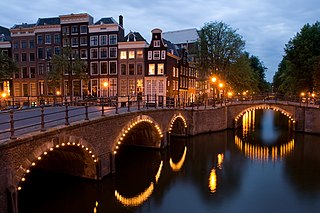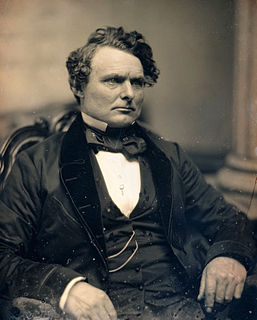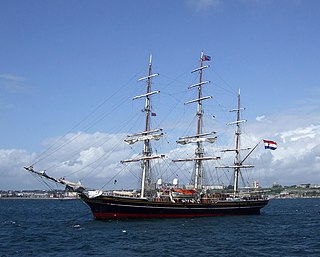This article does not cite any sources .(August 2007) (Learn how and when to remove this template message) |
While the majority of the clipper ships sailed under British and American flags, more than a hundred clippers were built in the Netherlands. They were medium clippers rather than the larger extreme clipper.

The Netherlands is a country located mainly in Northwestern Europe. The European portion of the Netherlands consists of twelve separate provinces that border Germany to the east, Belgium to the south, and the North Sea to the northwest, with maritime borders in the North Sea with Belgium, Germany and the United Kingdom. Together with three island territories in the Caribbean Sea—Bonaire, Sint Eustatius and Saba— it forms a constituent country of the Kingdom of the Netherlands. The official language is Dutch, but a secondary official language in the province of Friesland is West Frisian.
A medium clipper is a type of clipper designed for both cargo carrying capacity and speed. An evolutionary adaptation of the extreme clipper, the medium clipper had been invented by 1851, when the hull type appeared in U.S. shipyards. Medium clippers continued to be built until 1873, when Pilgrim, one of the last known medium clipper ships to be built, was launched by Joshua T. Foster from the shipyards of Medford, Massachusetts.
An extreme clipper is a clipper designed to sacrifice cargo capacity for speed. They had a bow lengthened above the water, a drawing out and sharpening of the forward body, and the greatest breadth further aft. Extreme clippers were built in the period 1845 to 1855.
At an exhibition in Amsterdam in 1852 the Dutch lieutenant-commander M.H. Jansen showed a model of a medium-clipper which he obtained from the shipbuilders Perrine, Patterson & Stack of Williamsburg, Brooklyn. The shipping company of Gebr. Blussé (Dordrecht) were very impressed by this model. This resulted in the launching of the clipper Kosmopoliet (800 tons) for the company in 1854. She is said to be the first Dutch clipper.

Williamsburg is a neighborhood in the New York City borough of Brooklyn, bordered by Greenpoint to the north; Bedford–Stuyvesant to the south; Bushwick and East Williamsburg to the east; and the East River to the west. Part of Brooklyn Community Board 1, the neighborhood is served in the south by the NYPD's 90th Precinct and in the north by the 94th Precinct. On the New York City Council, the western and southern parts of the neighborhood are represented by the 33rd District; and its eastern part by the 34th District. As of the 2010 United States Census, the neighborhood's population is 32,926, an increase of 2.0% from 2000.

Dordrecht, colloquially Dordt, historically in English named Dort, is a city and municipality in the Western Netherlands, located in the province of South Holland. It is the fourth-largest city of the province, with a population of 118,450. The municipality covers the entire Dordrecht Island, also often called Het Eiland van Dordt, bordered by the rivers Oude Maas, Beneden Merwede, Nieuwe Merwede, Hollands Diep, and Dordtsche Kil. Dordrecht is the largest and most important city in the Drechtsteden and is also part of the Randstad, the main conurbation in the Netherlands. Dordrecht is the oldest city in Holland and has a rich history and culture.
Kosmopoliet I is said to have been one of the first Dutch clippers.
But in 1850 the barque Magdalena (377 ton) was built in Amsterdam, and in 1853 four more ships with clipper lines were launched, of which the iron ship California (663 ton) is the most famous. She was built by Fop Smit, commanded by F.C. Jaski for the company L. Bienfait & sn. On her maiden voyage Jaski sailed her in 86 days from The Downs to Port Adelaide, delivering a hundred satisfied English immigrants.

Amsterdam is the capital city and most populous municipality of the Netherlands. Its status as the capital is mandated by the Constitution of the Netherlands, although it is not the seat of the government, which is The Hague. Amsterdam has a population of 854,047 within the city proper, 1,357,675 in the urban area and 2,410,960 in the metropolitan area. The city is located in the province of North Holland in the west of the country but is not its capital, which is Haarlem. The Amsterdam metropolitan area comprises much of the northern part of the Randstad, one of the larger conurbations in Europe, which has a population of approximately 8.1 million.

Fop Smit was a Dutch naval architect, shipbuilder, and shipowner. He founded the towage and salvage company L. Smit & Co that is now part of Smit International. His shipyard had a number of "firsts" in shipbuilding and produced a number of famous vessels.

The Downs are a roadstead in the southern North Sea near the English Channel off the east Kent coast, between the North and the South Foreland in southern England. In 1639 the Battle of the Downs took place here, when the Dutch navy destroyed a Spanish fleet which had sought refuge in neutral English waters. From the Elizabethan era onwards, the presence of the Downs helped to make Deal one of the premier ports in England, and in the 19th century, it was equipped with its own telegraph and timeball tower to enable ships to set their marine chronometers.
The Kosmopoliet also carried cargo and passengers. She was full-rigged and carried royals and skysails on all three masts. Though a voyage from the Netherlands to Java normally took a hundred days or more (port to port), the Kosmopoliet completed her maiden voyage in 89 days. Later she did the passage in 76, 74 and 77 days. In 1862 the Kosmopoliet II (1200 tons) was launched, followed by Kosmopolitet III, which measured 1385 tons.

A full-rigged ship or fully rigged ship is a sailing vessel's sail plan with three or more masts, all of them square-rigged. A full-rigged ship is said to have a ship rig or be ship-rigged.

A royal is a small sail flown immediately above the topgallant on square rigged sailing ships. It was originally called the "topgallant royal" and was used in light and favorable winds.

A skysail is the uppermost sail in many old square-rigged sail-plans. It was also on the royal mast above the royal sail. It was typically used in light winds.
Other companies soon followed Gebr. Blussé. Some clipper ships were purchased from abroad, like the Electra (formerly, Witch of the Wave), but most were built in Dutch shipyards. Other famous series were built, like the Noach I to VI (950 to 1350 tons), several Thorbecke's, the Lichtstraal (1260 tons), Voorlichter (1660 tons), Nestor, Utrecht, etc.
In 1874 a Dutch government investigation into the condition of the shipping industry, called the Enquête of 1874, stated that in 1868 sixteen clipper ships were registered, with a total tonnage of 6000 tons. In 1873 there were eighteen ships (totalling 7878 tons). However, other sources mention a greater number of ships that can be called medium clippers.
Probably there was a difference of opinion in the definition of the clipper. Maybe the ships in the Enquête were only called clipper when they were full rigged, but there were other rigs too. In 1854 for example, the Argo was launched as a 4-masted Jackass-barque. Others were rigged as barques and the Reinhart was a brigantine.

A jackass-barque, sometimes spelled jackass bark, is a sailing ship with three masts, of which the foremast is square-rigged and the main is partially square-rigged and partially fore-and-aft rigged (course). The mizzen mast is fore-and-aft rigged.

A barque, barc, or bark is a type of sailing vessel with three or more masts having the fore- and mainmasts rigged square and only the mizzen rigged fore-and-aft.

A brigantine is a two-masted sailing vessel with a fully square rigged foremast and at least two sails on the main mast: a square topsail and a gaff sail mainsail. The main mast is the second and taller of the two masts.










